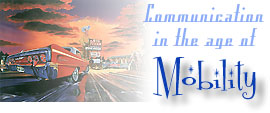
Office: HGH 210; phone: (408) 924-5378
Email: wooda@email.sjsu.edu
Web: http://www.sjsu.edu/faculty/wooda
 |
Dr. Andrew Wood Office: HGH 210; phone: (408) 924-5378 Email: wooda@email.sjsu.edu Web: http://www.sjsu.edu/faculty/wooda |
Introduction
: Course Calendar : Policies
: Readings
Assignments : Check Your Grades : Return
to Frontpage
Warning: This reading contains language which you may find objectionable. I suggest this piece, however, because of its value to our discussions about the nature of fluid locales. Please let me know if you have any concerns about this selection.
In his chapters, "The airport as city and community" and "Social activities within terminals" (pp. 20-37 and 78-80), Mark Gottdiener describes airports as gateways, transitional spaces which permit travelers to experience in small portion the "great escape" to experience vicarious versions of religious pilgrimage and transcendence. Yet, these gateways are more shopping malls than cathedrals. Gottdiener notes that the airport as retail space began in the 1970s when a new generation of larger aircraft mandated a redesign in terminals. Forced to abandon the "train terminal" as their architectural model, designers turned to the shopping mall for their vision of long pedestrian concourses.
Gottdiener offers plenty of parallels between airports and cities, suggesting that both converge in the trend toward environments that dehumanize, even as they provide individuals a dizzying array of opportunities to affirm a sense of self through various form of consumer activity. He notes that, aside from the occasionally noisy reunion of long separated loved ones: "Terminal space in our biggest airports has transcended the human performance it contains" (p. 22). This, he says, is representative of the larger postmodern culture in which subsumes the individual to an intersection of mass produced environments and media-constructed desires. Moreover, in response to the reasonable claim that airports are certainly NOT like cities because, in the latter, people reside for more than one or two hours, Gottdiener notes the growing trend for urban dwellers to occupy their homes for a few years before moving on, noting that we are all transitory, even at home. Of course, he then notes the distressing trend of airports becoming long-term homes away from home for travelers forced to endure missed connections and canceled flights.
In comparison to places which possess "meaning," Gottdiener describes airports as de-territorialized. De-territorialization refers to a "gradual de-emphasis of the importance of significant places" (p. 32). This trend is merely illustrated by the airport, itself a component of a larger matrix of semi-home and semi-work spaces that increasingly intersect with commercial and entertainment sites. The social impact of terminal life? "We are less the stalwarts of stable communities than temporary residents in transitory social communion of fellow travelers" (p. 33).
Supplemental Website: Two Nights in Reagan National Airport <http://www.sjsu.edu/faculty/wooda/175/175airport.html> - from my COMM 175 course: "Like Mike Davis' critical dissection of Los Angeles, one finds Reagan National to be a slightly dystopian corporate enclave. Reagan hardly bristles with menace, but you have little reason to tarry unless you're walking or shopping or, preferably, both."